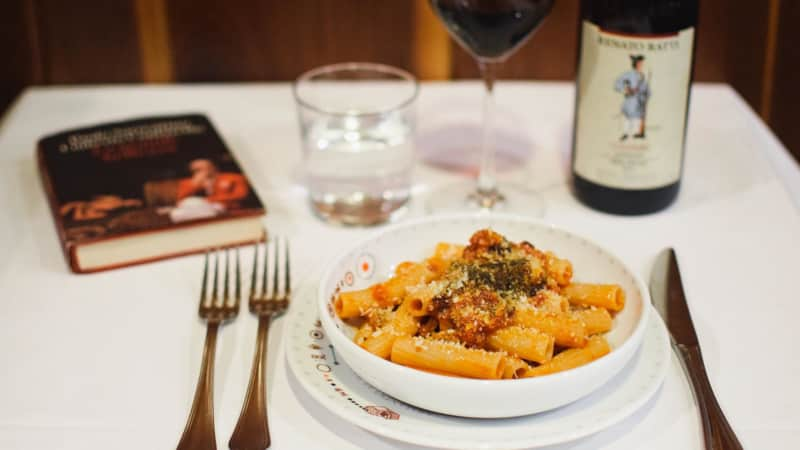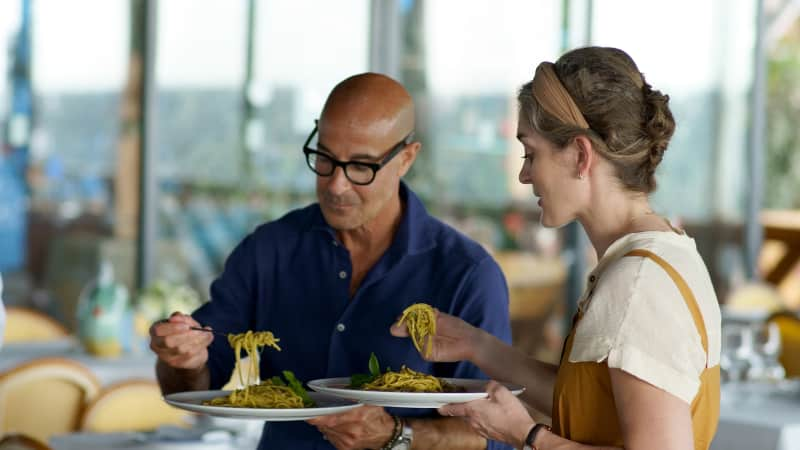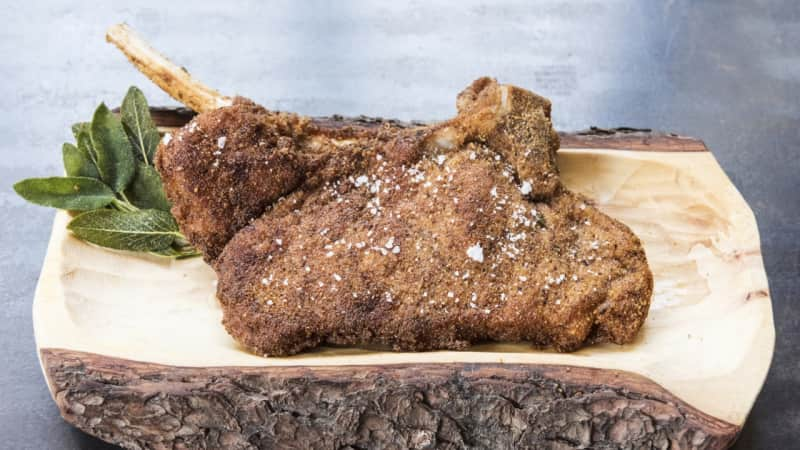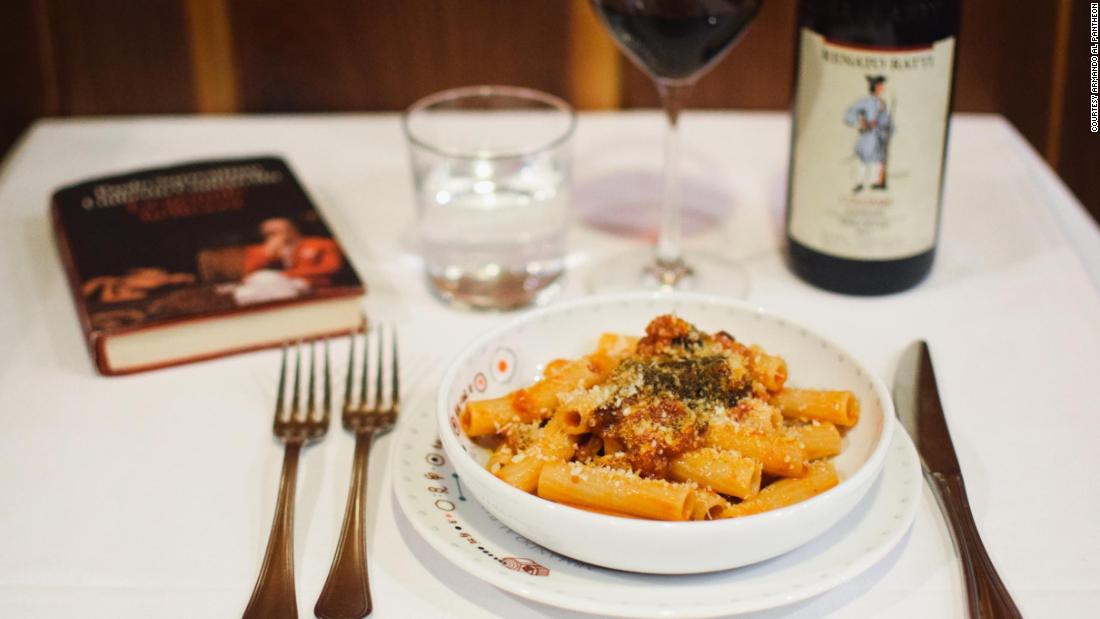Uncovering millennia of culinary history while weaving tales of local culture and real people, the show has had viewers salivating over the featured dishes and showcasing their own attempts to replicate them on Instagram and Twitter.
The recipes are listed in metric and US measurements and have been adapted for home use by the restaurant or chef.

Armando al Pantheon’s rigatoni all’Amatriciana
Courtesy Armando al Pantheon
Armando al Pantheon, Rome — Amatriciana
Recipe courtesy of Claudio Gargioli and Fabrizio Gargioli (chef and owners)
Serves 6
Ingredients
600g / 1¼ pounds rigatoni pasta (or bucatini)
120g / 4½ oz guanciale (cured pork jowl)
6-7 San Marzano tomatoes
100g / 3½ oz grated pecorino romano cheese
½ glass dry white wine
1 tablespoon extra virgin olive oil
Salt
Black pepper
Instructions
Fill a large pot with water, add salt and bring it to the boil.
In the meantime, heat the extra virgin olive oil in a frying pan. Chop the guanciale into thick strips, add it to the pan and cook until crispy. Add the white wine, cook for a minute to reduce, then remove the guanciale from the pan with a slotted spoon and set aside.
Add six or seven San Marzano tomatoes to the pan with the remaining oil and fat from the guanciale. Use a wooden spoon to flatten the tomatoes and simmer for a few minutes.
Cook the rigatoni in the pot of boiling water until al dente, add the crispy guanciale back into the pan of tomatoes then drain the pasta and add it to the sauce.
Toss everything together well then divide into portions and serve with a sprinkle of grated pecorino and a crack of freshly ground black pepper.
Pasta alla norma is a Sicilian favorite made with eggplant, and this version includes homemade, fresh-cut macaroni.
Ristorante Me Cumpari Turiddu, Catania — Pasta alla norma
Recipe courtesy of Gianluca Leocata (chef) and Roberta Capizzi (owner)
Serves 4
Ingredients
500g / 18 oz fresh macaroni (can use dried macaroni as an alternative)
500g / 18 oz eggplant
700ml / 1.5 pints tomato purée
5 fresh basil leaves
1 clove garlic
50g / 2 oz salted ricotta
Extra virgin olive oil
Vegetable oil, for frying
Salt
Instructions
Cut the eggplant lengthways into slices about 1 cm (⅓ inch) thick, sprinkle with salt and layer in a colander. Leave for at least 30 minutes to drain off any bitter juices.
Heat the vegetable oil in a large pan, rinse and dry the eggplant, then fry in batches until lightly golden.
Cut the fried eggplant into chunks (keeping some whole pieces aside for garnish).
In a separate pan, heat the olive oil with the whole, peeled garlic clove then add the strips of eggplant followed by the tomato purée (known as passata in Italy) and a fresh basil leaf. Leave to cook gently until the tomato sauce becomes dense and sweet.
When the sauce is almost ready, bring a large pot of salted water to boil and cook the pasta until al dente. Drain and add to the sauce, remove the garlic clove and mix well.
Divide into four bowls and top each with the reserved slices of eggplant, a grating of salted ricotta and a leaf of fresh basil.
Chef Fabio Picchi fills Stanley Tucci in on his family secret for delicious bistecca alla fiorentina.
C.BIO, Florence — Bistecca alla Fiorentina
Recipe courtesy of Fabio Picchi
Serves 3-4
Ingredients
1 fiorentina steak (porterhouse or T-bone) about 1.5kg / 3.5 lb
Extra virgin olive oil
Salt
A few small olive branches (optional as may only be found in more Mediterranean climates)
The key to a good fiorentina is a top-quality, well-aged piece of beef so be sure to visit a trusted butcher and request that the steak be cut to the height of a matchstick (about the width of three fingers).
The meat must be cooked over a hot grill, barbecue or fireplace for a truly authentic result.
Instructions
Leave the meat at room temperature for at least 8 hours before you plan to grill it.
Prepare the fire well in advance and make sure the embers are white-hot and glowing.
Now for the secret: distribute some small olive branches over the embers. This will not only prevent burning by catching the first fats that fall from the steak, but it will add an extra earthy element of flavor to the meat.
Place the meat on the grill and cook for 5 to 6 minutes then turn and cook the other side for a further 5 to 6 minutes. Sprinkle a generous amount of salt on each side during cooking.
Remove from the grill, carve out the bone and slice the meat into pieces. Arrange on a plate and drizzle with extra virgin olive oil before serving.
Stanley Tucci learns how to make the first recorded recipe of Bolognese ragu, which calls for onion, carrot, veal and bacon — but no tomato sauce and butter instead of oil.
Casa Artusi, Forlimpopoli — Tagliatelle alla bolognese
Recipe by Pellegrino Artusi (from his book “La scienza in cucina e l’arte di mangiar bene” published in 1891)
Serves 4
Ingredients
400g / 14 oz tagliatelle (or macaroni)
150g / 5½ oz lean veal (preferably fillet)
50g / 2 oz pancetta
40g / 1½ oz unsalted butter
¼ onion
½ carrot
2 medium celery stalks
1 tsp flour
500ml / 1 pint good beef stock
Salt
Black pepper
Nutmeg (optional)
Grated parmigiano reggiano cheese, to serve
Instructions
Bring a large pot of salted water to the boil for the pasta.
Cut the veal into very small pieces and finely chop the pancetta, onion, carrot and celery.
Heat the butter in a pan and add the veal, pancetta and vegetables all at the same time, season with black pepper and a tiny pinch of salt.
Once the veal has browned, add a sprinkle of flour, nutmeg if desired, and a ladle of stock.
Continue to cook for 10 minutes, continuing to add more stock as necessary.
In the meantime, cook the tagliatelle until al dente. Drain, toss together with the sauce and serve with grated parmigiano reggiano.

Spaghetti alle zucchine is a Tucci favorite.
CNN
Lo Scoglio, Massa Lubrense – Spaghetti alle zucchine
Recipe courtesy of Tommaso de Simone (chef)
Serves 4
Ingredients
400g / 14 oz spaghetti
6 medium zucchini
Grated parmigiano reggiano (preferably aged 2 years)
1 bunch fresh basil leaves
Sunflower oil, for frying
Salt
Black pepper (optional)
Instructions
Heat a generous amount of sunflower oil in a large saucepan.
Slice the zucchini into thin rounds and then fry in the hot oil until they begin to turn golden. Drain the zucchini with a slotted spoon, place in a bowl and leave in the fridge for at least two hours to rest and soften.
When you are ready to prepare the dish, bring a large pot of salted water to the boil and cook the spaghetti until al dente.
Heat the rested zucchini in a large frying pan along with 2 ladles of the spaghetti cooking water and season with a pinch of salt and freshly ground black pepper if desired.
Drain the spaghetti and add to the pan with the zucchini. Remove the pan from the heat, add a couple of handfuls of grated parmigiano reggiano and toss everything together well.
Divide into portions, sprinkle each bowl with more parmigiano reggiano and top with a few fresh basil leaves before serving.

Chef Cesare Battisti’s costoletta di vitello
Courtesy Ratanà
Ratanà, Milan– Costoletta di vitello
Recipe courtesy of Cesare Battisti (chef)
Serves 4
Ingredients
4 veal cutlets weighing 450g / 15 oz each
5 eggs
400g / 14 oz fine breadcrumbs
600g / 20 oz clarified butter
30-40 fresh sage leaves
Salt
Instructions
Trim any excess meat or fat from the bone of each cutlet, scraping the bone with a sharp knife to clean it completely.
Use your hands to flatten down the meat. Each cutlet should be approximately 2-3 cm (1 inch) thick.
Beat the eggs with a little salt then coat each cutlet first in egg and then in a layer of breadcrumbs, patting well so that they are evenly covered.
Cook each cutlet separately. Heat a tablespoon of clarified butter in a frying pan then place the breaded cutlet into the pan with 2 or 3 sage leaves and cook on a low heat for about 5 minutes. Don’t turn the cutlet over but continue to add more butter and sage during this time and constantly spoon over the melted butter to ensure that the top coating of breadcrumbs is golden and crispy.
Remove the cutlet and dry on absorbent paper. Leave it to rest for 2 minutes, sprinkle with salt and serve.
